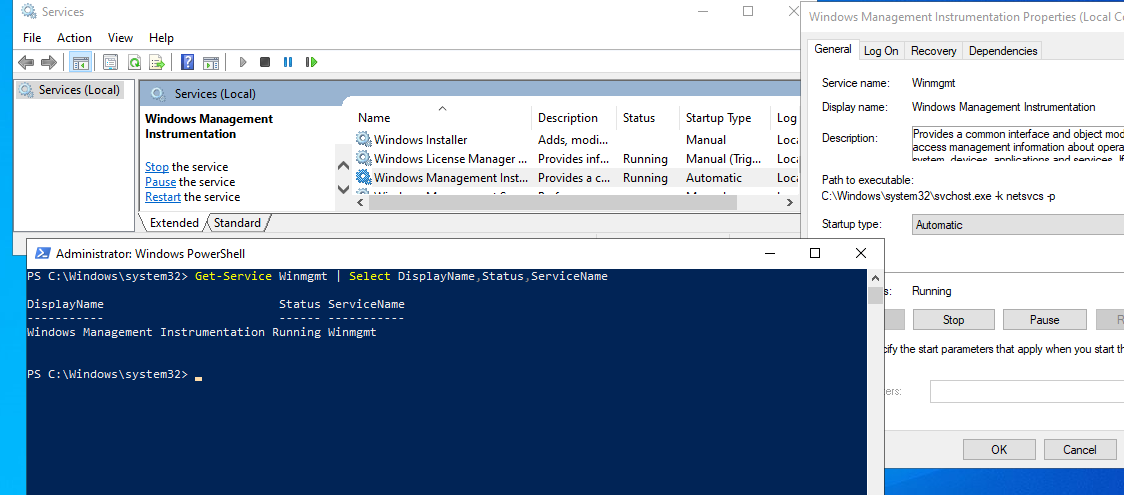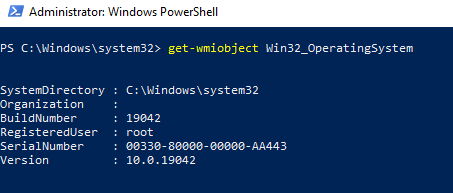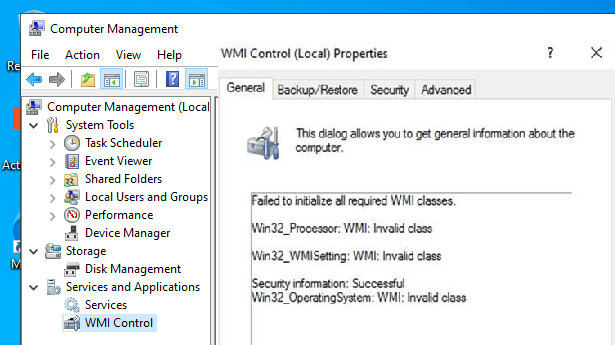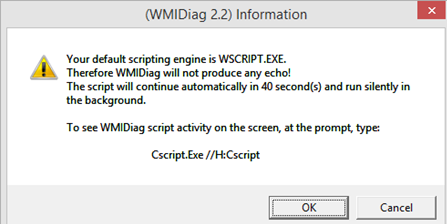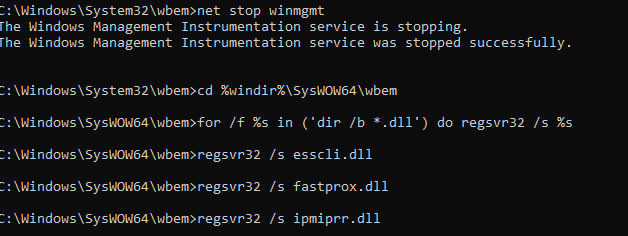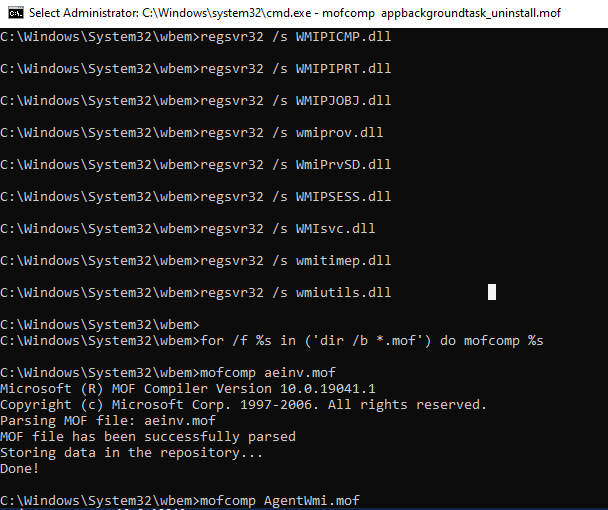- Remove From My Forums
-
Question
-
Please, I’m getting the error «invalid class» on my cmd when i typed «systeminfo.exe to check my visualization status as i needed to enable the VT-x in my BIOS setting.. please, what is wrong and what can i do?
thanks.
All replies
-
-
Edited by
Thursday, July 16, 2020 12:34 AM
-
Edited by
-
Hi,
If you see Invalid class then your WMI is not working correctly.
You could try the following steps:
open a CMD window and type at the cmd prompt:
net stop winmgmt (choose Y when needed)
winmgmt /resetrepository
net start winmgmt
Hope above information can help you.
This «Windows 10 General» Forum will be migrating to a new home on Microsoft Q&A, please refer to this
sticky
post for more details.
«Windows 10 General» forum will be migrating to a new home on
Microsoft Q&A!
We invite you to post new questions in the «Windows 10 General» forum’s new home on
Microsoft Q&A!
For more information, please refer to the
sticky post.
-
Edited by
FarenaMicrosoft contingent staff
Thursday, July 16, 2020 6:28 AM -
Proposed as answer by
FarenaMicrosoft contingent staff
Tuesday, July 21, 2020 8:24 AM
-
Edited by
-
Hi,
Just checking in to see if the information provided was helpful.
If the reply helped you, please remember to mark it as an answer.
If no, please reply and tell us the current situation in order to provide further help.
Please remember to mark the replies as answers if they help.
If you have feedback for TechNet Subscriber Support, contact
tnmff@microsoft.com. -
Hi,
Since you have not responded for a long time, please let us know if you would like further assistance.
If the reply is useful for you, please take it as answer.
If there is anything else we can do for you, please feel free to post in the forum.
Best Regards,
Farena
Please remember to mark the replies as answers if they help.
If you have feedback for TechNet Subscriber Support, contact
tnmff@microsoft.com.
A user reported that when she printed
Microsoft Excel spreadsheets or
QuickBooks
invoices, no text would appear on the printouts. She had reported the
same problem about a month ago. When I rebooted the system then, the problem
went away, but this time rebooting didn’t help. After I requested that
she reboot the system, I was told the problem remained, so when I was
able to get to the system to troubleshoot, I first checked to make sure
the system had been rebooted rather than QuickBooks simply being restarted.
It was then that I noticed a lot of other functionality was no longer
available. E.g., when I tried to
use the systeminfo command to find the last reboot time, I saw an error
message instead of the time the system was last rebooted.
Microsoft Windows [Version 10.0.15063] (c) 2017 Microsoft Corporation. All rights reserved. C:UsersPam>systeminfo | find /i "Boot" Loading Operating System Information ...ERROR: Invalid class C:UsersPam>systeminfo Loading Operating System Information ...ERROR: Invalid class C:UsersPam>wmic os get lastbootuptime os - Alias not found. C:UsersPam>
When the systeminfo command didn’t work, I then tried to get
the time of last reboot using
PowerShell, but that also didn’t work.
Windows PowerShell Copyright (C) 2016 Microsoft Corporation. All rights reserved. PS C:WINDOWSsystem32> (GCIM Win32_OperatingSystem).LastBootUpTime GCIM : Invalid class At line:1 char:2 + (GCIM Win32_OperatingSystem).LastBootUpTime + ~~~~~~~~~~~~~~~~~~~~~~~~~~ + CategoryInfo : MetadataError: (rootcimv2:Win32_OperatingSystem:String) [Get-CimInstance], CimException + FullyQualifiedErrorId : HRESULT 0x80041010,Microsoft.Management.Infrastructure.CimCmdlets.GetCimInstanceCommand PS C:WINDOWSsystem32>
So I rebooted the system, but rebooting didn’t alter the results when I
tried to run the commands again. I thought that, perhaps, a recently installed
update to Microsoft Windows might have caused the problem, so I tried
checking on recently
installed patches using PowerShell, but I again saw error messages
rather than the expected list of recently installed Microsoft Windows
updates.
PS C:UsersPam> Get-CimInstance -Class win32_quickfixengineering | Where-Object { $_.InstalledOn -gt (Get-Date).AddMonths(-1) } Get-CimInstance : Invalid class At line:1 char:1 + Get-CimInstance -Class win32_quickfixengineering | Where-Object { $_. ... + ~~~~~~~~~~~~~~~~~~~~~~~~~~~~~~~~~~~~~~~~~~~~~~~~ + CategoryInfo : MetadataError: (rootcimv2:win32_quickfixengineering:String) [Get-CimInstance], CimExcep tion + FullyQualifiedErrorId : HRESULT 0x80041010,Microsoft.Management.Infrastructure.CimCmdlets.GetCimInstanceCommand PS C:UsersPam>
When I logged off the user’s account and logged into the domain
administrator’s account and then opened a command prompt window, I saw
a result I’d never seen occur when opening a command prompt window on this
or any other system. The window title was unusual; it was
«Administrator: Microsoft Windows Server 2008 x64 DEBUG Build Environment»,
though the system was a Windows 10 system and the domain controller was
not a Windows Server 2008 system, and the command prompt window also didn’t
open to the usual Windows directory and the text displayed was yellow on a
black background, instead of white on a black background.
Setting SDK environment relative to C:Program FilesMicrosoft SDKsWindowsv7.0. Targeting Windows Server 2008 x64 DEBUG C:Program FilesMicrosoft SDKsWindowsv7.0>
When I attempted to run the systeminfo command, I got the same
«Loading Operating System Information …ERROR: Invalid class» error message.
When I ran the netstat -a command at the prompt, I saw a
continuously scrolling list of entries like the following ones:
TCP 127.0.0.1:12344 www:51415 ESTABLISHED TCP 127.0.0.1:12344 www:51418 ESTABLISHED TCP 127.0.0.1:12344 www:51419 ESTABLISHED TCP 127.0.0.1:12344 www:51423 ESTABLISHED TCP 127.0.0.1:12344 www:51426 ESTABLISHED TCP 127.0.0.1:12344 www:51429 ESTABLISHED TCP 127.0.0.1:12344 www:51438 TIME_WAIT TCP 127.0.0.1:12344 www:51456 ESTABLISHED TCP 127.0.0.1:12344 www:51459 ESTABLISHED TCP 127.0.0.1:12344 www:51461 ESTABLISHED TCP 127.0.0.1:12344 www:51463 TIME_WAIT TCP 127.0.0.1:12344 www:51469 ESTABLISHED TCP 127.0.0.1:12344 www:51473 ESTABLISHED TCP 127.0.0.1:12344 www:51475 ESTABLISHED TCP 127.0.0.1:12344 www:51479 TIME_WAIT
I had to interrupt the output with Ctrl-C, since it appeared it would
continue indefinitely. When I used netstat -an, I saw the
following:
C:Program FilesMicrosoft SDKsWindowsv7.0>netstat -an | more Active Connections Proto Local Address Foreign Address State TCP 0.0.0.0:80 0.0.0.0:0 LISTENING TCP 0.0.0.0:135 0.0.0.0:0 LISTENING TCP 0.0.0.0:445 0.0.0.0:0 LISTENING TCP 0.0.0.0:1801 0.0.0.0:0 LISTENING TCP 0.0.0.0:2103 0.0.0.0:0 LISTENING TCP 0.0.0.0:2105 0.0.0.0:0 LISTENING TCP 0.0.0.0:2107 0.0.0.0:0 LISTENING TCP 0.0.0.0:2215 0.0.0.0:0 LISTENING TCP 0.0.0.0:2869 0.0.0.0:0 LISTENING TCP 0.0.0.0:3389 0.0.0.0:0 LISTENING TCP 0.0.0.0:5357 0.0.0.0:0 LISTENING TCP 0.0.0.0:6646 0.0.0.0:0 LISTENING TCP 0.0.0.0:7680 0.0.0.0:0 LISTENING TCP 0.0.0.0:8733 0.0.0.0:0 LISTENING TCP 0.0.0.0:13000 0.0.0.0:0 LISTENING TCP 0.0.0.0:49664 0.0.0.0:0 LISTENING TCP 0.0.0.0:49665 0.0.0.0:0 LISTENING TCP 0.0.0.0:49666 0.0.0.0:0 LISTENING TCP 0.0.0.0:49667 0.0.0.0:0 LISTENING TCP 0.0.0.0:49668 0.0.0.0:0 LISTENING TCP 0.0.0.0:49669 0.0.0.0:0 LISTENING TCP 0.0.0.0:49673 0.0.0.0:0 LISTENING TCP 0.0.0.0:49688 0.0.0.0:0 LISTENING TCP 0.0.0.0:49699 0.0.0.0:0 LISTENING TCP 127.0.0.1:12342 0.0.0.0:0 LISTENING TCP 127.0.0.1:12344 0.0.0.0:0 LISTENING TCP 127.0.0.1:12344 127.0.0.1:51521 ESTABLISHED TCP 127.0.0.1:12344 127.0.0.1:51522 TIME_WAIT TCP 127.0.0.1:12344 127.0.0.1:51563 TIME_WAIT TCP 127.0.0.1:12344 127.0.0.1:51611 ESTABLISHED TCP 127.0.0.1:12344 127.0.0.1:51865 ESTABLISHED TCP 127.0.0.1:12344 127.0.0.1:51943 TIME_WAIT TCP 127.0.0.1:12344 127.0.0.1:51973 ESTABLISHED TCP 127.0.0.1:12350 0.0.0.0:0 LISTENING TCP 127.0.0.1:51364 127.0.0.1:51365 ESTABLISHED TCP 127.0.0.1:51365 127.0.0.1:51364 ESTABLISHED TCP 127.0.0.1:51366 127.0.0.1:12344 TIME_WAIT TCP 127.0.0.1:51368 127.0.0.1:12344 TIME_WAIT TCP 127.0.0.1:51370 127.0.0.1:12344 TIME_WAIT TCP 127.0.0.1:51374 127.0.0.1:51375 ESTABLISHED TCP 127.0.0.1:51375 127.0.0.1:51374 ESTABLISHED TCP 127.0.0.1:51380 127.0.0.1:12344 TIME_WAIT TCP 127.0.0.1:51382 127.0.0.1:12344 TIME_WAIT TCP 127.0.0.1:51384 127.0.0.1:12344 TIME_WAIT -- More --
When I tried to determine what process was listening on port 80
and on other ports with code netstat -anb, I saw quite
a few «Cannot obtain ownership information» results.
C:Program FilesMicrosoft SDKsWindowsv7.0>netstat -anb | more Active Connections Proto Local Address Foreign Address State TCP 0.0.0.0:80 0.0.0.0:0 LISTENING Can not obtain ownership information TCP 0.0.0.0:135 0.0.0.0:0 LISTENING RpcSs [svchost.exe] TCP 0.0.0.0:445 0.0.0.0:0 LISTENING Can not obtain ownership information TCP 0.0.0.0:1801 0.0.0.0:0 LISTENING [mqsvc.exe] TCP 0.0.0.0:2103 0.0.0.0:0 LISTENING [mqsvc.exe] TCP 0.0.0.0:2105 0.0.0.0:0 LISTENING [mqsvc.exe] TCP 0.0.0.0:2107 0.0.0.0:0 LISTENING [mqsvc.exe] TCP 0.0.0.0:2215 0.0.0.0:0 LISTENING [sshd.exe] TCP 0.0.0.0:2869 0.0.0.0:0 LISTENING Can not obtain ownership information TCP 0.0.0.0:3389 0.0.0.0:0 LISTENING TermService [svchost.exe] TCP 0.0.0.0:5357 0.0.0.0:0 LISTENING Can not obtain ownership information TCP 0.0.0.0:6646 0.0.0.0:0 LISTENING [mcsvhost.exe] TCP 0.0.0.0:7680 0.0.0.0:0 LISTENING DoSvc [svchost.exe] TCP 0.0.0.0:8733 0.0.0.0:0 LISTENING Can not obtain ownership information TCP 0.0.0.0:13000 0.0.0.0:0 LISTENING [NOBuClient.exe] TCP 0.0.0.0:49664 0.0.0.0:0 LISTENING Can not obtain ownership information TCP 0.0.0.0:49665 0.0.0.0:0 LISTENING EventLog [svchost.exe] TCP 0.0.0.0:49666 0.0.0.0:0 LISTENING [spoolsv.exe] TCP 0.0.0.0:49667 0.0.0.0:0 LISTENING Schedule [svchost.exe] TCP 0.0.0.0:49668 0.0.0.0:0 LISTENING [lsass.exe] TCP 0.0.0.0:49669 0.0.0.0:0 LISTENING SessionEnv [svchost.exe] TCP 0.0.0.0:49673 0.0.0.0:0 LISTENING [lsass.exe] TCP 0.0.0.0:49688 0.0.0.0:0 LISTENING [mqsvc.exe] TCP 0.0.0.0:49699 0.0.0.0:0 LISTENING Can not obtain ownership information TCP 127.0.0.1:12342 0.0.0.0:0 LISTENING [LavasoftTcpService.exe] TCP 127.0.0.1:12344 0.0.0.0:0 LISTENING [LavasoftTcpService.exe] TCP 127.0.0.1:12344 127.0.0.1:52192 TIME_WAIT TCP 127.0.0.1:12344 127.0.0.1:52193 TIME_WAIT TCP 127.0.0.1:12350 0.0.0.0:0 LISTENING [LavasoftTcpService.exe] TCP 127.0.0.1:51364 127.0.0.1:51365 ESTABLISHED [firefox.exe] TCP 127.0.0.1:51365 127.0.0.1:51364 ESTABLISHED [firefox.exe] TCP 127.0.0.1:51374 127.0.0.1:51375 ESTABLISHED [firefox.exe] TCP 127.0.0.1:51375 127.0.0.1:51374 ESTABLISHED [firefox.exe] TCP 127.0.0.1:51431 127.0.0.1:51432 ESTABLISHED [firefox.exe] TCP 127.0.0.1:51432 127.0.0.1:51431 ESTABLISHED [firefox.exe] TCP 127.0.0.1:51543 127.0.0.1:51544 ESTABLISHED [firefox.exe] TCP 127.0.0.1:51544 127.0.0.1:51543 ESTABLISHED [firefox.exe] TCP 127.0.0.1:52185 127.0.0.1:12344 TIME_WAIT TCP 127.0.0.1:52187 127.0.0.1:12344 TIME_WAIT TCP 127.0.0.1:52189 127.0.0.1:12344 TIME_WAIT TCP 192.168.0.15:139 0.0.0.0:0 LISTENING Can not obtain ownership information TCP 192.168.0.15:49846 65.52.108.199:443 ESTABLISHED WpnService [svchost.exe] TCP 192.168.0.15:50934 209.85.201.125:5222 ESTABLISHED [googledrivesync.exe] TCP 192.168.0.15:50935 216.58.217.170:443 CLOSE_WAIT [googledrivesync.exe] TCP 192.168.0.15:50937 216.58.217.170:443 CLOSE_WAIT [googledrivesync.exe] -- More --
I saw similar results for another Windows 10 system in the same
domain in the same office, although on that system, when I opened a
command prompt window with administrator privileges I saw the normal
«Administrator: Command Prompt» title for the window and it opened, as
usual, to the C:WINDOWSsystem32 directory.
When I checked to see if the system was configured to use a proxy
server for website access by querying the
Windows registry with the
Registry Editor regedit, I found the returned value was 0,
which indicated that the system wasn’t configured to use a proxy server.
C:Program FilesMicrosoft SDKsWindowsv7.0>reg query "HKEY_CURRENT_USERSoftwareMicrosoftWindowsCurrentVersionInternet Settings" /v ProxyEnable
HKEY_CURRENT_USERSoftwareMicrosoftWindowsCurrentVersionInternet Settings
ProxyEnable REG_DWORD 0x0
C:Program FilesMicrosoft SDKsWindowsv7.0>
I then tried netstat -aon and saw that a process with
process identifier 4 was listening on port 80.
C:Windows>netstat -aon Active Connections Proto Local Address Foreign Address State PID TCP 0.0.0.0:80 0.0.0.0:0 LISTENING 4 TCP 0.0.0.0:135 0.0.0.0:0 LISTENING 448 TCP 0.0.0.0:445 0.0.0.0:0 LISTENING 4 TCP 0.0.0.0:1801 0.0.0.0:0 LISTENING 4156 TCP 0.0.0.0:2103 0.0.0.0:0 LISTENING 4156 TCP 0.0.0.0:2105 0.0.0.0:0 LISTENING 4156 TCP 0.0.0.0:2107 0.0.0.0:0 LISTENING 4156 TCP 0.0.0.0:2215 0.0.0.0:0 LISTENING 7172 TCP 0.0.0.0:2869 0.0.0.0:0 LISTENING 4 TCP 0.0.0.0:3389 0.0.0.0:0 LISTENING 1036 TCP 0.0.0.0:5357 0.0.0.0:0 LISTENING 4 TCP 0.0.0.0:6646 0.0.0.0:0 LISTENING 4476 TCP 0.0.0.0:7680 0.0.0.0:0 LISTENING 7980 TCP 0.0.0.0:8733 0.0.0.0:0 LISTENING 4 TCP 0.0.0.0:13000 0.0.0.0:0 LISTENING 12280 TCP 0.0.0.0:49664 0.0.0.0:0 LISTENING 676 TCP 0.0.0.0:49665 0.0.0.0:0 LISTENING 1408 TCP 0.0.0.0:49666 0.0.0.0:0 LISTENING 2768 TCP 0.0.0.0:49667 0.0.0.0:0 LISTENING 1788 TCP 0.0.0.0:49668 0.0.0.0:0 LISTENING 840 TCP 0.0.0.0:49669 0.0.0.0:0 LISTENING 3000 TCP 0.0.0.0:49673 0.0.0.0:0 LISTENING 840 TCP 0.0.0.0:49688 0.0.0.0:0 LISTENING 4156 TCP 0.0.0.0:49699 0.0.0.0:0 LISTENING 824 TCP 127.0.0.1:12342 0.0.0.0:0 LISTENING 3128 TCP 127.0.0.1:12344 0.0.0.0:0 LISTENING 3128 TCP 127.0.0.1:12344 127.0.0.1:52471 TIME_WAIT 0 TCP 127.0.0.1:12344 127.0.0.1:52602 TIME_WAIT 0 TCP 127.0.0.1:12344 127.0.0.1:52603 TIME_WAIT 0 TCP 127.0.0.1:12350 0.0.0.0:0 LISTENING 3128 TCP 127.0.0.1:51364 127.0.0.1:51365 ESTABLISHED 19368 TCP 127.0.0.1:51365 127.0.0.1:51364 ESTABLISHED 19368 TCP 127.0.0.1:51374 127.0.0.1:51375 ESTABLISHED 9828 TCP 127.0.0.1:51375 127.0.0.1:51374 ESTABLISHED 9828 TCP 127.0.0.1:51431 127.0.0.1:51432 ESTABLISHED 19204 TCP 127.0.0.1:51432 127.0.0.1:51431 ESTABLISHED 19204 TCP 127.0.0.1:51543 127.0.0.1:51544 ESTABLISHED 19544 TCP 127.0.0.1:51544 127.0.0.1:51543 ESTABLISHED 19544 TCP 127.0.0.1:52473 127.0.0.1:12344 TIME_WAIT 0 TCP 127.0.0.1:52475 127.0.0.1:12344 TIME_WAIT 0 TCP 127.0.0.1:52477 127.0.0.1:12344 TIME_WAIT 0 TCP 127.0.0.1:52480 127.0.0.1:12344 TIME_WAIT 0 TCP 127.0.0.1:52482 127.0.0.1:12344 TIME_WAIT 0 TCP 127.0.0.1:52483 127.0.0.1:12344 TIME_WAIT 0 TCP 127.0.0.1:52486 127.0.0.1:12344 TIME_WAIT 0 TCP 127.0.0.1:52487 127.0.0.1:12344 TIME_WAIT 0 TCP 127.0.0.1:52490 127.0.0.1:12344 TIME_WAIT 0 TCP 127.0.0.1:52492 127.0.0.1:12344 TIME_WAIT 0 TCP 127.0.0.1:52495 127.0.0.1:12344 TIME_WAIT 0 TCP 127.0.0.1:52499 127.0.0.1:12344 TIME_WAIT 0 TCP 127.0.0.1:52505 127.0.0.1:12344 TIME_WAIT 0 TCP 127.0.0.1:52507 127.0.0.1:12344 TIME_WAIT 0 TCP 127.0.0.1:52509 127.0.0.1:12344 TIME_WAIT 0 TCP 127.0.0.1:52511 127.0.0.1:12344 TIME_WAIT 0 TCP 127.0.0.1:52512 127.0.0.1:12344 TIME_WAIT 0 TCP 127.0.0.1:52517 127.0.0.1:12344 TIME_WAIT 0 TCP 127.0.0.1:52518 127.0.0.1:12344 TIME_WAIT 0 TCP 127.0.0.1:52531 127.0.0.1:12344 TIME_WAIT 0 TCP 127.0.0.1:52535 127.0.0.1:12344 TIME_WAIT 0 TCP 127.0.0.1:52539 127.0.0.1:12344 TIME_WAIT 0 TCP 127.0.0.1:52543 127.0.0.1:12344 TIME_WAIT 0 TCP 127.0.0.1:52547 127.0.0.1:12344 TIME_WAIT 0 TCP 127.0.0.1:52548 127.0.0.1:12344 TIME_WAIT 0 TCP 127.0.0.1:52549 127.0.0.1:12344 TIME_WAIT 0 TCP 127.0.0.1:52555 127.0.0.1:12344 TIME_WAIT 0 TCP 127.0.0.1:52559 127.0.0.1:12344 TIME_WAIT 0 TCP 127.0.0.1:52563 127.0.0.1:12344 TIME_WAIT 0 TCP 127.0.0.1:52565 127.0.0.1:12344 TIME_WAIT 0 TCP 127.0.0.1:52583 127.0.0.1:12344 TIME_WAIT 0 TCP 127.0.0.1:52589 127.0.0.1:12344 TIME_WAIT 0 TCP 127.0.0.1:52590 127.0.0.1:12344 TIME_WAIT 0 TCP 127.0.0.1:52591 127.0.0.1:12344 TIME_WAIT 0 TCP 127.0.0.1:52592 127.0.0.1:12344 TIME_WAIT 0 TCP 127.0.0.1:52596 127.0.0.1:12344 TIME_WAIT 0 TCP 127.0.0.1:52599 127.0.0.1:12344 TIME_WAIT 0 TCP 127.0.0.1:52601 127.0.0.1:12344 TIME_WAIT 0 TCP 127.0.0.1:52604 127.0.0.1:12344 TIME_WAIT 0 TCP 127.0.0.1:52606 127.0.0.1:12344 TIME_WAIT 0 TCP 127.0.0.1:52607 127.0.0.1:12344 TIME_WAIT 0 TCP 127.0.0.1:52608 127.0.0.1:12344 TIME_WAIT 0 TCP 127.0.0.1:52620 127.0.0.1:12344 TIME_WAIT 0 TCP 127.0.0.1:52627 127.0.0.1:12344 TIME_WAIT 0 TCP 127.0.0.1:52629 127.0.0.1:12344 TIME_WAIT 0 TCP 127.0.0.1:52631 127.0.0.1:12344 TIME_WAIT 0 TCP 192.168.0.15:139 0.0.0.0:0 LISTENING 4 TCP 192.168.0.15:49846 65.52.108.199:443 ESTABLISHED 3588 TCP 192.168.0.15:50934 209.85.201.125:5222 ESTABLISHED 16512 TCP 192.168.0.15:50935 216.58.217.170:443 CLOSE_WAIT 16512 TCP 192.168.0.15:50937 216.58.217.170:443 CLOSE_WAIT 16512 TCP 192.168.0.15:50938 216.58.217.170:443 CLOSE_WAIT 16512 TCP 192.168.0.15:52474 23.32.80.49:80 TIME_WAIT 0 TCP 192.168.0.15:52478 72.21.91.29:80 TIME_WAIT 0 TCP 192.168.0.15:52493 52.84.121.202:443 TIME_WAIT 0 TCP 192.168.0.15:52506 52.84.125.5:443 TIME_WAIT 0 TCP 192.168.0.15:52508 216.58.217.104:443 TIME_WAIT 0 TCP 192.168.0.15:52510 216.58.217.110:443 TIME_WAIT 0 TCP 192.168.0.15:52514 216.58.217.102:443 TIME_WAIT 0 TCP 192.168.0.15:52532 172.217.7.130:443 TIME_WAIT 0 TCP 192.168.0.15:52536 216.58.217.110:80 TIME_WAIT 0 TCP 192.168.0.15:52540 172.217.3.34:443 TIME_WAIT 0 TCP 192.168.0.15:52544 173.194.207.157:443 TIME_WAIT 0 TCP 192.168.0.15:52551 172.217.3.34:443 TIME_WAIT 0 TCP 192.168.0.15:52552 74.125.29.156:443 TIME_WAIT 0 TCP 192.168.0.15:52553 54.192.16.21:443 TIME_WAIT 0 TCP 192.168.0.15:52560 74.125.202.104:443 TIME_WAIT 0 TCP 192.168.0.15:52564 52.84.123.36:443 TIME_WAIT 0 TCP 192.168.0.15:52566 52.84.125.5:443 TIME_WAIT 0 TCP 192.168.0.15:52584 52.84.125.136:443 TIME_WAIT 0 TCP 192.168.0.15:52609 23.4.187.27:80 TIME_WAIT 0 TCP 192.168.0.15:52618 104.100.157.32:443 ESTABLISHED 2728 TCP 192.168.0.15:52619 104.100.157.32:443 ESTABLISHED 2728 TCP 192.168.0.15:52621 216.58.217.110:443 TIME_WAIT 0 TCP [::]:80 [::]:0 LISTENING 4 TCP [::]:135 [::]:0 LISTENING 448 TCP [::]:445 [::]:0 LISTENING 4 TCP [::]:1801 [::]:0 LISTENING 4156 TCP [::]:2103 [::]:0 LISTENING 4156 TCP [::]:2105 [::]:0 LISTENING 4156 TCP [::]:2107 [::]:0 LISTENING 4156 TCP [::]:2215 [::]:0 LISTENING 7172 TCP [::]:2869 [::]:0 LISTENING 4 TCP [::]:3389 [::]:0 LISTENING 1036 TCP [::]:5357 [::]:0 LISTENING 4 TCP [::]:7680 [::]:0 LISTENING 7980 TCP [::]:8733 [::]:0 LISTENING 4 TCP [::]:49664 [::]:0 LISTENING 676 TCP [::]:49665 [::]:0 LISTENING 1408 TCP [::]:49666 [::]:0 LISTENING 2768 TCP [::]:49667 [::]:0 LISTENING 1788 TCP [::]:49668 [::]:0 LISTENING 840 TCP [::]:49669 [::]:0 LISTENING 3000 TCP [::]:49673 [::]:0 LISTENING 840 TCP [::]:49688 [::]:0 LISTENING 4156 TCP [::]:49699 [::]:0 LISTENING 824 UDP 0.0.0.0:123 *:* 1100 UDP 0.0.0.0:3389 *:* 1036 UDP 0.0.0.0:3702 *:* 2816 UDP 0.0.0.0:3702 *:* 2816 UDP 0.0.0.0:5050 *:* 1500 UDP 0.0.0.0:5353 *:* 1192 UDP 0.0.0.0:5355 *:* 1192 UDP 0.0.0.0:6646 *:* 4476 UDP 0.0.0.0:52847 *:* 2768 UDP 0.0.0.0:60175 *:* 2816 UDP 127.0.0.1:1900 *:* 6792 UDP 127.0.0.1:50822 *:* 840 UDP 127.0.0.1:54749 *:* 1692 UDP 127.0.0.1:60612 *:* 7980 UDP 127.0.0.1:62720 *:* 6792 UDP 192.168.0.15:137 *:* 4 UDP 192.168.0.15:138 *:* 4 UDP 192.168.0.15:1900 *:* 6792 UDP 192.168.0.15:62719 *:* 6792 UDP [::]:123 *:* 1100 UDP [::]:3389 *:* 1036 UDP [::]:3702 *:* 2816 UDP [::]:3702 *:* 2816 UDP [::]:5353 *:* 1192 UDP [::]:5355 *:* 1192 UDP [::]:60176 *:* 2816 UDP [::1]:1900 *:* 6792 UDP [::1]:62718 *:* 6792 UDP [fe80::e90f:c172:eb14:f3a4%2]:1900 *:* 6792 UDP [fe80::e90f:c172:eb14:f3a4%2]:62717 *:* 6792 C:Windows>
When I tried to use the tasklist command to associate an application
name with PID 4, though, I saw an error message.
C:Windows>tasklist /fi "PID eq 4" ERROR: Invalid class C:Windows>
On the other Windows 10 system, I saw the image name listed as
«System».
From the administrator account, I tried again to see when the last
Windows updates were installed, but still saw error messages instead of
information on installed patches.
PS C:UsersAdministrator> Get-CimInstance -class win32_quickfixengineering Get-CimInstance : Invalid class At line:1 char:1 + Get-CimInstance -class win32_quickfixengineering + ~~~~~~~~~~~~~~~~~~~~~~~~~~~~~~~~~~~~~~~~~~~~~~~~ + CategoryInfo : MetadataError: (rootcimv2:win32_quickfixengineering:String) [Get-CimInstance], CimExcep tion + FullyQualifiedErrorId : HRESULT 0x80041010,Microsoft.Management.Infrastructure.CimCmdlets.GetCimInstanceCommand PS C:UsersAdministrator> Get-Hotfix Get-Hotfix : Invalid class At line:1 char:1 + Get-Hotfix + ~~~~~~~~~~ + CategoryInfo : NotSpecified: (:) [Get-HotFix], ManagementException + FullyQualifiedErrorId : System.Management.ManagementException,Microsoft.PowerShell.Commands.GetHotFixCommand PS C:UsersAdministrator>
However, on the other Windows 10 system in the office, when I used the
Get-Hotfix cmdlet, I saw the list of recently installed patches;
October 17 was the date for the most recently installed one with the
immediately prior installed patch being installed on October 11. The
Get-CimInstance -class win32_quickfixengineering also worked
and showed the same results.
I was able to view recent updates by typing update
in the Cortana «Ask me anything» window then selecting «View your Update
History» in the returned results. I saw recent application updates, but
no operating system update that I thought might create the problem I
was seeing.
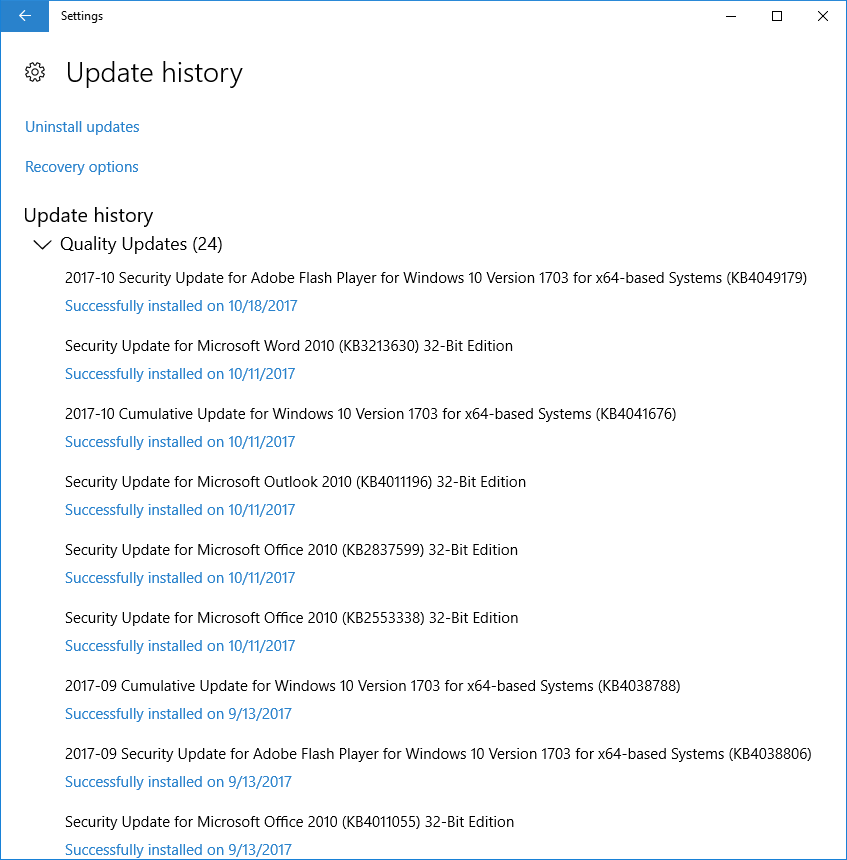
I found that other PowerShell cmdlets weren’t working, either. E.g.,
when I tried the Get-Disk
cmdlet, instead of seeing information on the disk drives in and attached to
the system, nothing was displayed.
PS C:UsersPam> Get-Disk
PS C:UsersPam>
PowerShell 5.1 is installed on the system.
PS C:UsersPam> $psversiontable
Name Value
---- -----
PSVersion 5.1.15063.674
PSEdition Desktop
PSCompatibleVersions {1.0, 2.0, 3.0, 4.0...}
BuildVersion 10.0.15063.674
CLRVersion 4.0.30319.42000
WSManStackVersion 3.0
PSRemotingProtocolVersion 2.3
SerializationVersion 1.1.0.1
PS C:UsersPam>
I then tried commands to
check the Windows
operating system version at a PowerShell prompt.
Though [System.Environment]::OSVersion.Version displayed the
operating system version,
(Get-WmiObject -class Win32_OperatingSystem).Caption displayed
an error message, though both worked fine on the other system in the office
running the same version and build of Microsoft Windows.
PS C:UsersPam> [System.Environment]::OSVersion.Version
Major Minor Build Revision
----- ----- ----- --------
10 0 15063 0
PS C:UsersPam> (Get-WmiObject -class Win32_OperatingSystem).Caption
Get-WmiObject : Invalid class "Win32_OperatingSystem"
At line:1 char:2
+ (Get-WmiObject -class Win32_OperatingSystem).Caption
+ ~~~~~~~~~~~~~~~~~~~~~~~~~~~~~~~~~~~~~~~~~~
+ CategoryInfo : InvalidType: (:) [Get-WmiObject], ManagementException
+ FullyQualifiedErrorId : GetWMIManagementException,Microsoft.PowerShell.Commands.GetWmiObjectCommand
PS C:UsersPam>
Windows Management Instrumentation Command-line (WMIC)
commands that worked without issues on the other system also failed to produce
the expected output on this system.
C:UsersPam>wmic os os - Alias not found. C:UsersPam>
I thought there might be some corruption to Windows operating system
files or one or more may have been deleted or altered, so I ran the
Deployment Image Servicing and Management (DISM) tool and then the
System File Checker (SFC) tool. To use those tools
open a command prompt with
administrator privileges then run the
DISM command shown below first. DISM
enumerates, installs, uninstalls, configures, and updates features
and packages in Windows images. DISM uses Windows Update to provide the files
that are needed to fix a corrupted Windows operating system.
C:WINDOWSsystem32>dism /online /cleanup-image /restorehealth Deployment Image Servicing and Management tool Version: 10.0.15063.0 Image Version: 10.0.15063.0 [==========================100.0%==========================] The restore operati on completed successfully. The operation completed successfully. C:WINDOWSsystem32>
After the DISM command completes, run the
System File Checker (SFC) command
shown below. The SFC utility checks for incorrect versions of all protected
operating system files and replaces any found to be corrupted or incorrect
with the correct version from the compressed %WinDir%System32dllcache directory. You can see the value of the
environment variable %WinDir% on a particular system by typing
the command echo %WinDir% command at a command prompt. It is
usually the C:Windows directory. In this case, SFC did not
find any problems, though I was expecting it to report an issue with one
or more files.
C:WINDOWSsystem32>sfc /scannow Beginning system scan. This process will take some time. Beginning verification phase of system scan. Verification 100% complete. Windows Resource Protection did not find any integrity violations. C:WINDOWSsystem32>
I thought there might be malware on the system creating the problem
even though the system is scanned regularly by the antivirus software on
the system, McAfee Total Protection. I also run an automatic nightly
scan of the system with
SUPERAntispyware, but it hasn’t been reporting anything but tracking
cookies. I also installed
Malwarebytes Anti-Malware and
checked the system with it, but it didn’t report any malware infections.
Nor did I see anything suspicious when I checked the programs that are
automatically started at boot time with Microsoft’s
Autoruns for Windows.
I decided I would update Windows to the recently released
Fall Creators Update of Windows 10. I typed
update in the
Cortana
«Type here to search» field and then selected «Check for updates»
from the results list. At the Settings window, I clicked on
the Check for updates button which initiated an installation of
Windows 10, version 1709. After the update was installed and I rebooted
the system, all of the previously encountered problems were gone. I could
issue the systeminfo, WMIC and PowerShell command and get expected results.
I could also print normally from Microsoft Excel and the QuickBooks
accounting program.
Related articles:
-
Finding Time of Last Reboot
-
List Installed Security Patches with PowerShell
-
Querying disks with the PowerShell Get-Disk cmdlet
-
Using PowerShell to determine the installed version of Windows
- Obtaining a command prompt in Windows 10
-
Obtaining a Command Prompt on a
Windows 8 System - DISM command syntax
- System File Checker (SFC) command syntax
WMI Invalid class but «WMI repository is consistent»
Details: 1 On my Windows 10 Pro 64-bit PC, when I go to WMI Control in Computer Management under «Services and Applications» and select «More Actions» -> Properties, it displays the following:- Failed to initialize all required WMI classes. Win32_Processor: WMI: Invalid class Win32_WMISetting: WMI: Invalid class invalid class error windows 10
› Verified 5 days ago
› Url: Stackoverflow.com View Details
› Get more: Invalid class error windows 10View Warning
WMI: Missing or Failing WMI Providers or Invalid WMI Class
Details: WebWindows Management Instrumentation fails due to receiving an event or error concerning missing or failure to load WMI Provider, or Invalid WMI class, or WMI … get netadapter invalid class
› Verified 3 days ago
› Url: Techcommunity.microsoft.com View Details
› Get more: Get netadapter invalid classView Warning
windows 10 — systeminfo ERROR: not found — Super User
Details: WebC:WindowsSystem32systeminfo /s windows and it prompts me to insert a password. I tried inserting my LOCAL ADMIN password, and on another try, my … configuration refresh failed invalid class
› Verified 6 days ago
› Url: Superuser.com View Details
› Get more: Configuration refresh failed invalid classView Warning
How to fix «Invalid Class» in Powershell
Details: Web1.) Has anyone seen this before, and if so, what did you do to resolve it? 2.) Does anyone know if there is a way to rebuild/reinstall the WMI Classes? 3.) As the … wmi invalid namespace fix
› Verified 3 days ago
› Url: Social.technet.microsoft.com View Details
› Get more: Wmi invalid namespace fixView Warning
systeminfo does not work — Microsoft Community
Details: WebReplied on November 16, 2015 Report abuse Its not possible for Windows to do that. Once a particular architecture is installed, that is default architecture. What you should be … invalid class 0x80041010
› Verified 5 days ago
› Url: Answers.microsoft.com View Details
› Get more: Invalid class 0x80041010View Warning
Invalid Class Error [0x80041010] — Virtually Boring
Details: WebIf you see Invalid class then your WMI is not working correctly. Bad Good Troubleshooting: The first step is to download the Microsoft WMIDiag Tool. It will analyze WMI and give you a report with … invalid namespace root cimv2
› Verified 7 days ago
› Url: Virtuallyboring.com View Details
› Get more: Invalid namespace root cimv2View Warning
Windows Server 2012 R2 Can’t refresh: Error ‘Invalid Class’
Details: WebError : Configuration refresh failed with the following error: Invalid class 1-12-2014 any help?! Can’t find a thing on google.. Already rebooted and tried to rebuild WMI local_offer Windows Server 2012 R2 … get netnat invalid class
› Verified 2 days ago
› Url: Community.spiceworks.com View Details
› Get more: Get netnat invalid classView Warning
[SOLVED] “ERROR: Provider load failure” — Tom’s …
Details: Web19 0 10,510 Mar 21, 2020 #1 Hi there Whenever I try to run this command in PS: “PS C:Windowssystem32> systeminfo.exe”, I get this: “Loading Operating System …
› Verified 4 days ago
› Url: Forums.tomshardware.com View Details
› Get more: WarningsView Warning
Invalid Class — WMI Fix — Your Company :: Knowledgebase
Details: WebTo Fix: Open the command prompt, type wmimgmt.msc, and hit enter Right-click WMI Control (Local), and then click Properties. If Win32_Process shows ‘invalid …
› Verified 7 days ago
› Url: Tranact.com View Details
› Get more: WarningsView Warning
Windows 7 WMI repair (systeminfo does not work)
Details: WebWhen I type systeminfo in the CMD, I get ERROR: Invalid access to memory location. Also if I try to see the computer specs by right clicking on computer -> …
› Verified Just Now
› Url: Social.technet.microsoft.com View Details
› Get more: WarningsView Warning
Windows 7 WMI repair (systeminfo does not work)
Details: WebWhen I type systeminfo in the CMD, I get ERROR: Invalid access to memory location. Also if I try to see the computer specs, it says Processor: Not available, …
› Verified 4 days ago
› Url: Forums.tomshardware.com View Details
› Get more: WarningsView Warning
systeminfo Microsoft Learn
Details: WebDescription. /s <computer>. Specifies the name or IP address of a remote computer (do not use backslashes). The default is the local computer. /u …
› Verified 1 days ago
› Url: Learn.microsoft.com View Details
› Get more: AddressView Warning
How to fix “Invalid Class” error when monitoring a process
Details: WebCheck for “Disable Performance Counters” value in the right pane. If it’s there and set to 1, that’s the problem. Set it to 0 and reboot the computer. This should be …
› Verified Just Now
› Url: Blog.overseer-network-monitor.com View Details
› Get more: WarningsView Warning
Repair corrupt WMI installations Troubleshooting Scanning Issues
Details: WebKnowledge Base Troubleshooting Scanning Issues Repairing a corrupt WMI installation Options Repairing a corrupt WMI installation Lansweeper pulls Windows …
› Verified 5 days ago
› Url: Community.lansweeper.com View Details
› Get more: WarningsView Warning
configuration — Systeminfo, a C++ class to retrieve system …
Details: WebConsider making Systeminfo a POD. I would separate getting information from the SMBIOS from how to store the result. Make Systeminfo a plain old struct: …
› Verified 3 days ago
› Url: Codereview.stackexchange.com View Details
› Get more: WarningsView Warning
«Invalid class» error when creating new object for Win32
Details: Web1. Use «Win32_OperatingSystem=@» to get the current instance of the Win32_OperatingSystem class. @ means that an object is singleton, which is mentioned …
› Verified 1 days ago
› Url: Stackoverflow.com View Details
› Get more: WarningsView Warning
Text not printing, PowerShell cmdlets not working, etc.
Details: WebWhen I attempted to run the systeminfo command, I got the same «Loading Operating System Information ERROR: Invalid class» error message. When I ran the …
› Verified 5 days ago
› Url: Support.moonpoint.com View Details
› Get more: WarningsView Warning
Where is SYSTEM_INFORMATION_CLASS defined? — Stack Overflow
Details: Web3 Answers. Sorted by: 8. As stated in the documentation, this enum is defined in the Winternl.h header file. The definition in the header file from the version 7.1 SDK is: …
› Verified 6 days ago
› Url: Stackoverflow.com View Details
› Get more: WarningsView Warning
Windows Service Monitor — Invalid class — SolarWinds
Details: WebError: Invalid class Environment SAM 6.8 — EOL;SAM 6.9;SAM 2020.2 Cause Scenario #1 There is an issue with WMI on the target machine. Scenario #2 This …
› Verified 7 days ago
› Url: Support.solarwinds.com View Details
› Get more: WarningsView Warning
eDrawings Invalid Class error — General Q&A — GoEngineer …
Details: WebAnswer this question Ask a question Question Bob Potts Members 54 Posted August 11, 2022 I’ve run into an issue with my versions of eDrawings. When I try …
› Verified Just Now
› Url: Community.goengineer.com View Details
› Get more: WarningsView Warning
Whenever I view System Info I get a WMI Error Activation Required
Details: WebIf you see Invalid class then your WMI is not working correctly. Ultimately check How to Troubleshoot, Repair and Rebuild the WMI Repository? How to …
› Verified 8 days ago
› Url: Tenforums.com View Details
› Get more: WarningsView Warning
Любой бывалый Windows-админ периодически сталкивается с проблемами в работе службы WMI (Windows Management Instrumentation) и ее компонентах. Наличие проблем в подсистеме WMI является критичным с точки зрения нормального функционирования Windows, поэтому администратору необходимо проверить и восстановить работоспособность WMI. В этой статье мы опишем простую методику диагностирования и устранения неполадок службы WMI в Windows.
О наличии проблем с WMI может свидетельствовать широкий спектр ошибок:
- Ошибки обработки WMI запросов в системных журналах и логах приложений (
0x80041002 - WBEM_E_NOT_FOUND
,
WMI: Not Found
,
0x80041010 WBEM_E_INVALID_CLASS
); - Ошибки обработки GPO, связанные на WMI ( некорректная работа wmi фильтров групповых политик, и пр.);
- WMI запросы выполняются очень медленно;
- Ошибки при установке или работе агентов SCCM/SCOM;
- Ошибки в работе скриптов (vbs или PowerShell), использующих пространство имен WMI (скрипты с Get-WmiObject и т.д.).
Содержание:
- Диагностика проблем с WMI
- Исправление WMI репозитория, перерегистрация библиотек, перекомпиляция MOF файлов
- Сброс и пересоздание WMI репозитория (хранилища)
Диагностика проблем с WMI
В первую очередь нужно проверить служба Windows Management Instrumentation (Winmgmt) установлена в Windows и запущена. Вы можете проверить состояние службы в консоли services.msc или с помощью PowerShell:
Get-Service Winmgmt | Select DisplayName,Status,ServiceName
Если служба Winmgmt запущена, вы можете проверить работоспособность WMI, обратившись к ней с помощью простого WMI-запроса. Вы можете выполнить wmi запрос из командной строки или из PowerShell. Например, следующая команда выведет список установленных в Windows программ:
wmic product get name,version
Простейшая PowerShell команда для получения информации о версии и билда Windows 10 через WMI может выглядеть так:
get-wmiobject Win32_OperatingSystem
Как вы видите, служба WMI ответила на запрос корректно. Если при выполнении такого WMI-запроса Windows возвращает ошибку, скорее всего сервиса WMI работает некорректно, поврежден WMI репозиторий или есть какие-то другие проблемы.
В моем случае, например, при открытии свойств WMI Control в консоли управления компьютером (compmgmt.msc) появлялась надпись:
Failed to initialize all required WMI classes Win32_Processor. WMI: Invalid namespace Win32_WMISetting. WMI: Invalid namespace Win32_OperationSystem. WMI: Invalid namespace
Ранее для диагностики WMI существовала официальная утилита от Microsoft – WMIDiag.vbs (Microsoft WMI Diagnosis). WMIdiag это vbs скрипт, который проверяет различные подсистемы WMI и записывает собранную информацию в лог файлы (по умолчанию логи находятся в каталоге %TEMP% — C:USERS%USERNAME%APPDATALOCALTEMP). Получившийся отчет состоит из файлов, имена которых начинаются с WMIDIAG-V2.2 и включает в себя следующие типы фалов:
- .log файлы содержат подробный отчет об активности и работе утилиты WMIDiag;
- .txt файлы содержат итоговые отчеты о найденных ошибках, на которые стоит обратить внимание;
- В .csv файлах содержится информация, нужная для долгосрочного анализа работы подсистемы WMI.
Совет. В 64 битных версиях Windows wmidiag нужно запускать так:
c:windowsSystem32cscript.exe wmidiag.vbs
в противном случае появится ошибка:
WMIDiag must be run from native 64-bit environment. It is not supported in Wow64.
После окончания работы утилиты WMIDiag администратор должен изучить полученные файлы логов, проанализировать и попытаться исправить найденные ошибки.
К сожалению, последняя версия WMIDiag 2.2 корректно работает только с версиями до Windows 8.1/Windows Server 2012 R2. На данный момент Microsoft даже удалила ссылку на загрузку WMIDiag из Download Center. Но при желании, этот скрипт можно найти в сети.
WMIDiag может дать подробную информацию по исправлению частных ошибок в WMI, но в большинстве случаев процесс это довольно трудоемкий и стоит потраченного времени только при решении инцидентов в критичных системах (как правило, на продуктивных серверах). Для массового сегмента рабочих станций пользователей сбросить и пересоздатьWMI репозиторий в Windows.
Исправление WMI репозитория, перерегистрация библиотек, перекомпиляция MOF файлов
В Windows 10/Windows Server 2016 вы можете проверить целостность репозитория WMI с помощью команды:
winmgmt /verifyrepository
Если команда возвращает, что база данных WMI находится в неконсистентном состоянии (INCONSISTENT или WMI repository verification failed), стоит попробовать выполнить “мягкое” исправление ошибок репозитория:
Winmgmt /salvagerepository
WMI repository has been salvaged.
Данная команда выполняет проверку согласованности хранилища WMI и при обнаружении несогласованности перестраивает базу данных WMI.
Перезапустите службу WMI:
net stop Winmgmt
net start Winmgmt
Если стандартный способ исправления ошибок в WMI не помог, попробуйте следующий скрипт. Данный скрипт представляет собой ”мягкий” вариант восстановления службы WMI на компьютере (выполняется перерегистрация dll библиотек и службы WMI, перекомпилируются mof файлы). Данная процедура является безопасной и ее выполнение не должно привести к каким-либо новым проблемам с системой.
sc config winmgmt start= disabled
net stop winmgmt
cd %windir%system32wbem
for /f %s in ('dir /b *.dll') do regsvr32 /s %s
wmiprvse /regserver
sc config winmgmt start= auto
net start winmgmt
for /f %s in ('dir /b *.mof') do mofcomp %s
for /f %s in ('dir /b *.mfl') do mofcomp %s
На 64 битной версии Windows эти действия нужно также выполнить для каталога SysWOW64. Замените третью строку на
cd %windir%SysWOW64wbem
Указанные команды можно выполнить путем простой вставки в окно командой строки, либо сохранить код в bat файле wmi_soft_repair.bat и запустить его с правами администратора. После окончания работы скрипта, перезагрузите Windows и проверьте работу WMI.
Сброс и пересоздание WMI репозитория (хранилища)
Если вам не помогли мягкие способ восстановления WMI, рассмотренные выше, придется перейти к более “жесткому” способу восстановления работоспособности службы WMI, заключающегося в пересоздании хранилищаWMI.
WMI репозиторий (хранилище) находится в каталоге
%windir%System32WbemRepository
и представляет собой базу данных, в которой содержится информация о метаданных и определениях WMI классов. В некоторых случаях WMI репозиторий может содержать статическую информацию классов. При повреждении репозитория WMI, в работе службы Windows Management Instrumentation (Winmgmt) могут наблюдаться ошибки вплоть до полной невозможности ее запустить.
Если вы подозреваете, что репозиторий WMI поврежден, имейте в виду, что его пересоздание — это последняя шаг, к которому нужно прибегнуть только тогда, когда другие операции не помогают реанимировать WMI.
Следующая команда выполнит сброс базы данных WMI к исходному состоянию (как после чистой установки Windows). Используйте эту команду для выполнения hard reset репозитория WMI, если параметре salvagerepository не исправил проблему:
Winmgmt /resetrepository
Совет. На практике бывают случаи, когда пересоздание хранилища WMI приводит к проблемам со сторонним софтом. Это связано с тем, что все записи в базе WMI обнуляются (до состояния чистой системы). Такие программы скорее всего, придется переустанавливать в режиме восстановления.
Если обе команды (
Winmgmt /salvagerepository
и
Winmgmt /resetrepository
) не восстановили консистентное состояние базы WMI, попробуйте выполнить “жесткое” пересоздание базы WMI вручную таким скриптом:
sc config winmgmt start= disabled
net stop winmgmt
cd %windir%system32wbem
winmgmt /resetrepository
winmgmt /resyncperf
if exist Repos_bakup rd Repos_bakup /s /q
rename Repository Repos_bakup
regsvr32 /s %systemroot%system32scecli.dll
regsvr32 /s %systemroot%system32userenv.dll
for /f %s in ('dir /b *.dll') do regsvr32 /s %s
for /f %s in ('dir /b *.mof') do mofcomp %s
for /f %s in ('dir /b *.mfl') do mofcomp %s
sc config winmgmt start= auto
net start winmgmt
wmiprvse /regserver
На 64 битной версии Windows нужно также перерегистрировать dll/exe и перекомпилировать mof файлы в каталоге %windir%sysWOW64wbem.
Данный скрипт полностью пересоздает хранилище WMI (старый репозиторий сохраняется в каталог Repos_bakup). После окончания работы скрипта нужно перезагрузить Windows. Затем протестируйте работу службы WMI простым запросом.
Проверьте состояние WMI репозитория. Если ошибки исправлены, команда
winmgmt /verifyrepository
должна вернуть:
WMI repository is consistent
В этой статье мы собрали основные способы, позволяющие продиагностировать и устранить неполадки службы и репозитория WMI.
Кто-нибудь, кто когда-либо пытался запустить старый или новый проект в Visual Studio, и он не работает (код ошибки «VS 20xx / C #»)? легко определится с этим уроком.
В реальных условиях, когда предпринята попытка открыть любую другую программу и Microsoft .NET Framework (4.5.2, 4.5.3 или любую другую версию), может появиться сообщение об ошибке, в котором говорится « Недопустимое имя класса Windows »?
Почему сообщение об ошибке?
«Неверное имя класса Windows» может возникать по ряду причин, в том числе:
- Поврежденный компонент .Net Framework
- неисправные водители
- поврежденные файлы
- Проблемы TreeView в Visual Studio
- Взаимодействие DLL и антивирусного программного обеспечения
- или проблема с конкретным программным обеспечением.
Компоненты Windows .Net Framework могут быть повреждены, если компьютер регулярно не выключается должным образом .
Эти внезапные отключения компьютера могут быть результатом сбоев питания в сети или вне сети или проблемы с питанием самого компьютера.
Это также может привести к созданию нескольких поврежденных файлов, которые могут вызвать ошибку «Недопустимое имя класса Windows».
В некоторых случаях пользователи могут столкнуться с этой ошибкой после обновления некоторых компонентов конкретной программы.
Недопустимое имя класса Windows [FIX]
Ниже приведены некоторые советы, которые помогут вам полностью решить эту проблему.
1. Удалите и переустановите определенное программное обеспечение
Это самое простое исправление, и оно работает в некоторых случаях. Просто найдите программу в « Установка и удаление программ» и нажмите « Удалить» . Следуйте инструкциям, чтобы завершить процесс.
После удаления программного обеспечения перезагрузите компьютер и начните новую установку определенного программного обеспечения.
После завершения процесса установки запустите программу, и ошибка «Недопустимое имя класса Windows» должна быть исправлена.
- Рекомендуется: Как удалить остатки программного обеспечения
2. Запустите проверку средства проверки системных файлов.
Сканирование SFC используется для проверки состояния защищенных системных файлов с помощью параметра sfc / scannow в командной строке. Sfc / scannow — наиболее популярная форма команды sfc.
При этом будут проверены все критические системные файлы Windows на компьютере, включая файлы DLL .
Если SFC обнаружит проблему с любым из системных файлов Windows, он исправит ее.
Использование опции sfc / scannow потребует около 5-15 минут для завершения процесса проверки и ремонта.
Выполните следующие процедуры для исправления системных файлов Windows с помощью средства проверки системных файлов:
- Удерживайте WinKey + S или Q, чтобы вызвать панель поиска Windows
Введите cmd, щелкните правой кнопкой мыши результат и запустите от имени администратора. Это часто называют «повышенной» командной строкой - После запуска командной строки введите sfc / scannow и нажмите клавишу ВВОД, чтобы начать этап проверки.
- SFC теперь будет проверять и проверять целостность всех защищенных системных файлов Windows. Этот процесс может занять некоторое время.
Как только проверка достигает 100 процентов, может применяться любое из следующих:
- Если SFC не обнаружил проблем с защищенными файлами ОС на компьютере
- Или проблемы были найдены с системными файлами и исправлены. Любой пользователь также может проверить полный файл журнала здесь: C: \ Windows \ Logs \ CBS \ CBS.log (при условии, что Windows установлена на диске C :).
- Этот журнал может быть полезен в качестве ресурса для персонала технической поддержки, который может помочь с расширенными функциями устранения неполадок.
- Если при сканировании SFC обнаружены проблемы с системными файлами и их устранены, может быть предложено перезагрузить компьютер. В противном случае просто продолжите перезапуск.
- После перезапуска повторите попытку запуска определенного процесса или программы, которая вызвала ошибку «Недопустимое имя класса окна», чтобы увидеть, исправила ли SFC проблему.
3. Переустановите или отремонтируйте .Net Framework

Если отображаемое сообщение об ошибке имеет какое-либо отношение к .Net Framework, то восстановление или переустановка могут просто помочь.
Чтобы устранить проблемы .Net Framework, перейдите на веб-сайт Microsoft и следуйте инструкциям по загрузке NetFxRepairTool.exe.
Этот инструмент поможет обнаружить и попытаться устранить проблемы, связанные с настройкой .Net Framework или его обновлений.
После установки следуйте инструкциям в приложении, чтобы начать процедуру восстановления .Net Framework.
После завершения процесса перезагрузите этот компьютер и попробуйте запустить процесс, вызывающий ошибку «имя класса окна не является допустимым», теперь его следует исправить.
Чтобы удалить и установить Microsoft .Net Framework, выполните следующие действия:
1. Закройте все открытые прикладные программы
2. Нажмите WinKey + R, чтобы открыть диалоговое окно запуска.
3. Введите в панели управления и нажмите Enter
4. Нажмите «Добавить / Удалить программы» или «Удалить программу».
5. Выберите версию .Net Framework, установленную на вашем компьютере, и выберите Изменить / Удалить, Восстановить или Удалить
6. Появится мастер установки, выберите «Удалить / удалить» и нажмите «Далее».
7. Перезагрузите компьютер после завершения процесса.
8. После перезагрузки этого компьютера перейдите на страницу поддержки Microsoft, чтобы загрузить совместимую версию Microsoft .Net Framework.
В данном случае это Microsoft .Net Framework версии 4.7.1.

После завершения процесса установки пользователю может быть предложено перезагрузить компьютер. Если никаких подсказок не происходит, продолжайте перезапуск.
9. После перезагрузки компьютера попробуйте запустить программное обеспечение, которое вызывает ошибку «Недопустимое имя класса окна», и оно должно работать нормально.
- Рекомендуется: Как исправить ошибку контрольной суммы CMOS в Windows 10
4. Инициировать отладку в Microsoft Visual Studio без процесса ее размещения.

«Имя класса Windows недопустимо» может возникать всякий раз, когда пользователь пытается отладить или запустить существующий проект / создать новый в Microsoft Visual Studio, и он выбрасывает эту строку.
Если Visual Studio был переустановлен с последним пакетом обновления, и проблема не устранена. Чтобы отключить процесс хостинга, выполните следующую процедуру:
1. Откройте библиотеку классов или проект службы (проекты, которые не производят исполняемые файлы)
2. Нажмите «Свойства» в меню «Проект».
3. Откройте вкладку «Отладка» в окне «Свойства».
4. Снимите флажок Включить процесс размещения Visual Studio
Примечание . Отключение процесса размещения делает некоторые функции отладки недоступными, что может привести к снижению производительности.
Было обнаружено, что отладка без использования хост-процесса VS устраняет ошибку «Недопустимое имя класса окна». Испытав эти шаги, VS должен быть свободен от проблем.
5. Проверьте наличие проблем с питанием машины.
Применение уже описанных исправлений будет работать только в течение короткого периода времени, если на используемом компьютере возникают проблемы с питанием.
Когда происходит внезапное отключение из-за сбоя питания , может быть создано несколько поврежденных файлов, что, в свою очередь, приведет к рассматриваемой ошибке.
Диагностируйте и устраняйте проблемы с питанием на вашей машине, и все будет работать нормально.
Статьи по Теме:
- Исправлено: «Это приложение не может работать на вашем компьютере» в Windows 10
- Как исправить ошибку файловой системы (-2018375670) в Windows 10
- Идентичность этого сайта или целостность этого соединения не может быть подтверждена [FIX]
- Remove From My Forums
-
Question
-
I was directed to this board, so I’m reposting my question here:
I have suddenly lost my systeminfo functionality in Windows 7 Professional 64bit. When I type systeminfo in the CMD, I get ERROR: Invalid access to memory location. Also if I try to see the computer specs by right clicking on computer -> properties, it says Processor: Not available, and Memory: Not available. Also trying the msinfo32, it says «can’t collect information» and doesnt show any of the system info. I cannot pinpoint when exactly this problem started occuring, but these things used to work for me. How do I fix this problem?
Answers
-
I suggest you do In-place Upgrade to repair the system. To do so, launch the installation program, and then choose Upgrade.
Arthur Xie — MSFT
-
Marked as answer by
Monday, March 8, 2010 2:48 AM
-
Marked as answer by


